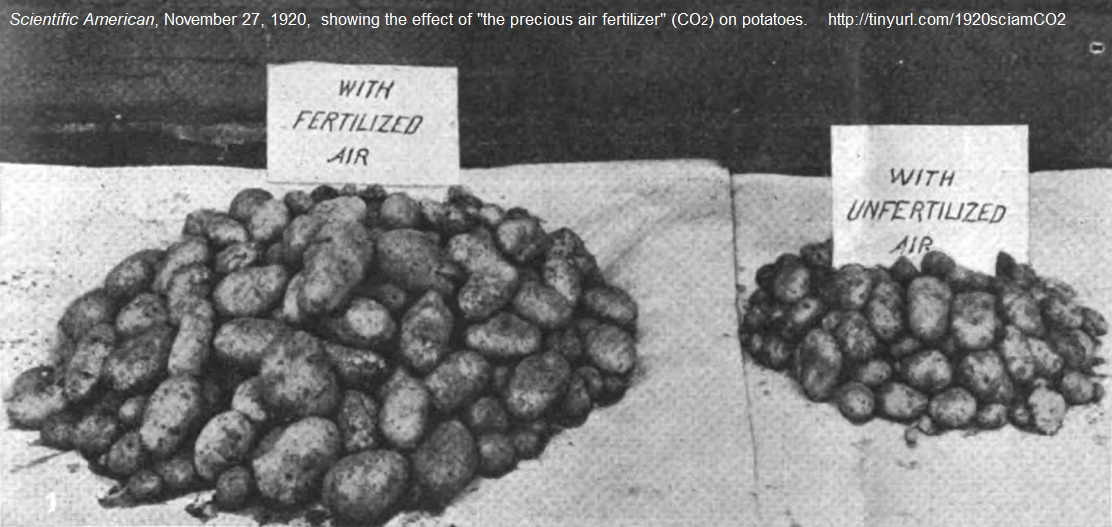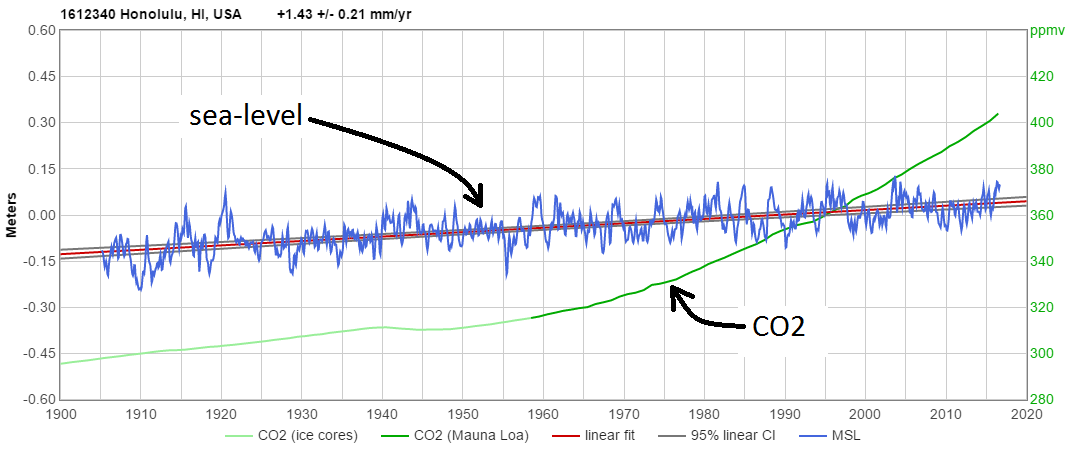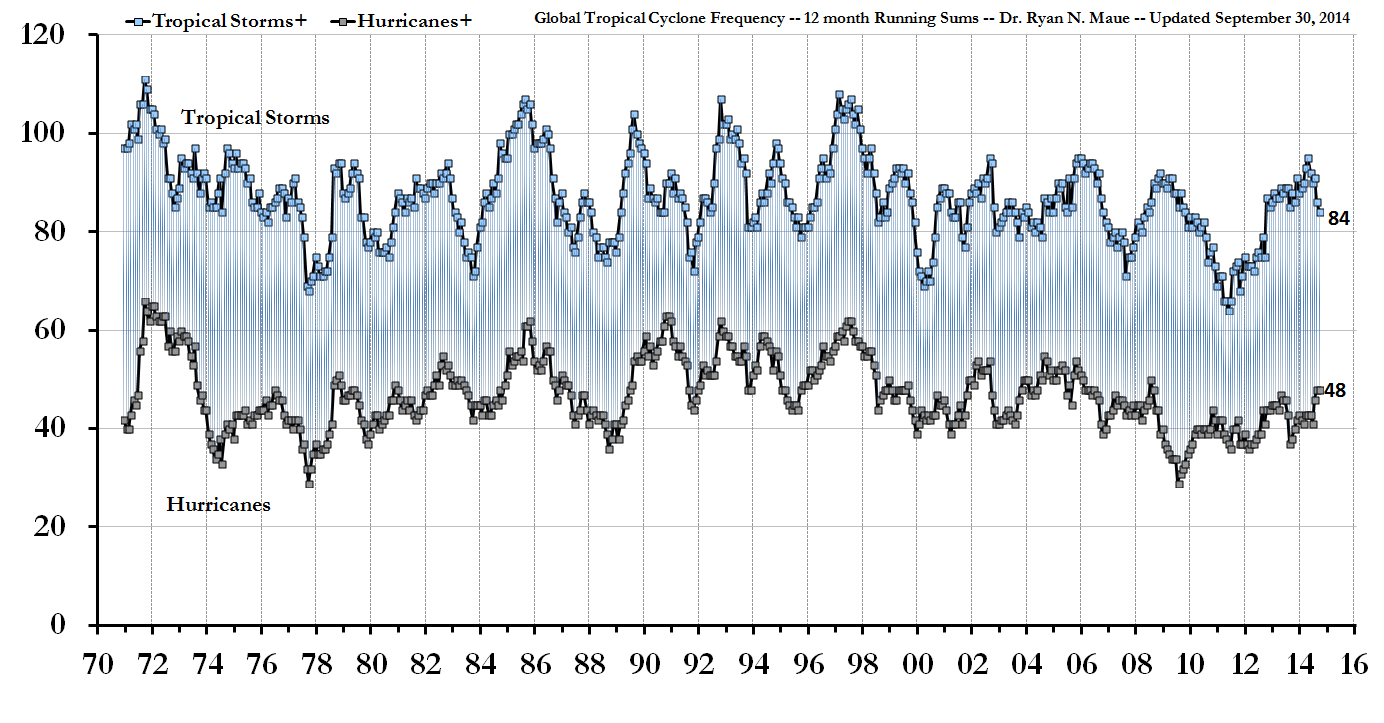This article is anti-scientific nonsense. If you are gullible enough to believe it, you need to read a more balanced mix of information. If you’re much worried about climate change it means you’re not doing that.
The best evidence is that anthropogenic global warming is real, but modest and benign.
If you read only alarmist sources, you will get a different (inaccurate) impression. So if you want to learn about climate science...
Start here: ClimateCurious.com
Then read an in-depth, written, 18-month-long, online debate between one prominent climate realist and two prominent climate alarmists, here: TheBestSchools: The Most Rigorous Debate on Climate Change & Global Warming
Then keep up with news on the top climate
blog: WUWT
Next, to dive deeper into the science, examine the numbers — and discover they are not very alarming.
If you can't quantify it, you don't understand it." - Peter Drucker
The IPCC represents the Left/alarmist end of the spectrum of opinion, and they project a total “equilibrium” warming (“ECS”) of about 3°C for a “doubling” of CO2. (That’s probably too high.)
Note that the warming effect of CO2 is logarithmically diminishing. The higher CO2 levels go, the less effect additional CO2 has. One ppmv of CO2 added today has only about 75% of the effect of one ppmv of CO2 added a century ago, when CO2 was just over 300 ppmv.
One “doubling” relative to “pre-industrial” (roughly 285 ppmv) means increasing CO2 by 285 ppmv, from 285 ppmv (in the early 1800s) to 570 ppmv (a level we are likely to reach near the end of the 21st century).
CO2 levels might someday exceed 570 ppmv, but probably not by much. The higher the levels go, the faster terrestrial and ocean feedbacks remove it, and there’s a limit to how much fossil fuel can be burned.
Note that we’ll never get a 2nd “doubling.” That would require quadrupling the pre-industrial 285 ppmv, taking the total to 1140 ppmv, which is certainly impossible.
What’s more, “equilibrium” means after several centuries, and the anthropogenic CO2 “pulse” probably won’t stay above 400 ppmv for that long. “Transient climate response” (TCR) is estimated to be about 2/3 of ECS, or if the IPCC is right about 2°C. TCR is a better metric for realistic projections.
Compared to “pre-industrial” (Little Ice Age) temperatures, if you accept all the adjustments, which have increased the reported warming, we’re up about 1°C so far. If you doubt the correctness of the adjustments it’s even less.
If all of the warming since the Little Ice Age is due to anthropogenic GHGs (as the IPCC assumes but I doubt), then 1°C of warming so far is consistent with TCR of about 2°C, which means ECS of about 3°C — the IPCC’s central value — because the CO2 we’ve added to the atmosphere (taking CO2 from about 285 ppmv to about 405 ppmv) is already about half of one “doubling.” (+120 might not seem like half of +285, but it is on a log-scale.)
If some of that warming was natural (as is likely), then TCR & ECS are even lower.
Assuming the worst case, that all the warming since the LIA is due to anthropogenic GHGs, then if CO2 gets to 570 ppmv — likely near the end of the century, absent a big shift to nuclear or other non-fossil-fuel energy — that would represent one full “doubling” since pre-industrial levels. From that, using the IPCC’s numbers, we should expect a total of about 2°C warming from that CO2 level compared to the Little Ice Age, and eventually 3°C warming if CO2 levels stay at that level for a few centuries (which is unlikely).
But we’ve already experienced about 1°C of that warming, so the net warming compared to present should be only about an additional 1°C (TCR) or 2°C (ECS).
So, figure on only 1 to 2 °C of additional warming, worst case, by the end of the century.
For comparison, from ice core isotope analysis it is believed that Antarctica warmed a total of about 10 °C over the course of the last deglaciation!
From this climate/hardiness zone map you can see that 1 to 2 °C of warming is roughly equivalent to moving only about 50 to 100 miles south, in the United States:
http://sealevel.info/zones-2015-with-scale.png

Or, if you’re above sea-level, 1 to 2 °C of warming is about the same temperature change you’d get from a reduction in elevation of 500 to 1000 feet.
In other words, even using the IPCC’s pessimistic figures, the expected warming is slight.
What's more, the "global warming" isn't really very global. It is expected to mostly be at extreme latitudes. They call that "polar amplification." The tropics aren't warming much, which is nice, because they're already warm enough. Instead, most of the warming is making brutal climates at extreme latitudes a little bit less harsh.
The rate of global warming is so tiny that it is
utterly dwarfed by normal, natural climate
fluctuations, and cyclical processes like ENSO. In
fact, the rate of warming is so tiny that it is very
difficult even to resolve with our measurements, as
demonstrated by the fact that corrections &
adjustments account for a large portion of the
reported warming even in the United States, which has
much better measurements than most places.
Next, learn about CO2 fertilization (“greening”).
If the sources you read only mention feared negative effects of carbon emissions, they are not balanced. The truth is that the benefits of anthropogenic CO2 almost certainly exceed any negative effects. The benefits are large and well-documented, and the negative effects are hypothetical, and mostly minor, or unlikely, or both.
The main benefit is that additional CO2 is highly beneficial for both agriculture and natural ecosystems. Already, at least 15% of agricultural production is due to the benefits of anthropogenic CO2, and the higher levels go the greater the benefit.
This is not new information. Scientific American wrote about it nearly 100 years ago! They called anthropogenic CO2 “the precious air fertilizer.” From this photo, you can see why:
http://sealevel.info/CO2_fertilized_potatoes_1920.png

Here's what anthropogenic CO2 is really doing for the biosphere:
http://news.nationalgeographic.com/news/2009/07/090731-green-sahara.html
Follow the link and learn that even wildly alarmist National Geographic admits that anthropogenic climate change is “greening” deserts, though they couldn't quite bring themselves to say it's the CO2 that's responsible. Here's an excerpt:
Images taken between 1982 and 2002 revealed extensive regreening throughout the Sahel, according to a new study in the journal Biogeosciences.
The study suggests huge increases in vegetation in areas including central Chad and western Sudan. ...
In the eastern Sahara area of southwestern Egypt and northern Sudan, new trees—such as acacias—are flourishing, according to Stefan Kröpelin, a climate scientist at the University of Cologne's Africa Research Unit in Germany.
"Shrubs are coming up and growing into big shrubs. This is completely different from having a bit more tiny grass," said Kröpelin, who has studied the region for two decades. ...
"Before, there was not a single scorpion, not a single blade of grass," he said.
"Now you have people grazing their camels in areas which may not have been used for hundreds or even thousands of years. You see birds, ostriches, gazelles coming back, even sorts of amphibians coming back," he said.
"The trend has continued for more than 20 years. It is indisputable."
Here's another fact for you to mull over: at least
15% of current agricultural productivity is a direct
result of CO2 fertilization, from anthropogenic CO2
emissions. If mankind had to do without that
additional production, we could almost, but not
quite, make up the
deficit by
putting all the world's rain forests under
cultivation.
Next, look for evidence of negative effects of global warming — and fail.
Most of the imagined negative effects simply aren’t happening.
The worst effect of anthropogenic GHG emissions is supposed to be sea-level rise. But that’s nonsense. We’ve done the experiment and seen the result:
2/3 century of heavy GHG emissions, and the associated global warming, have resulted in no detectable increase in the minuscule current average rate of sea-level rise. E.g., here's an excellent-quality, 111-year-long, mid-Pacific, sea-level measurement record, at a tectonically stable site, with a very typical trend:
Honolulu, HI, USA (NOAA 1612340, 760-031, PSMSL
155)
http://www.sealevel.info/1612340_Honolulu_vs_CO2_annot1.png

http://www.sealevel.info/MSL_graph.php?id=Honolulu
As you can see, 2/3 century of rising CO2 levels from heavy fossil fuel use, and the associated global warming, have caused no acceleration at all in the rate of sea-level rise, which averages only about 6 inches per century.
In fact, global sea-level rise is so slow that in many places it is dwarfed by the effect of local vertical land motion, so that some places experience declining sea-level instead of rising sea-level:
Vaasa/Vasa, Finland (NOAA 060-051, PSMSL
57)
http://sealevel.info/060-051_Vassa_2016-12_vs_CO2.png

The other major negative effect is supposed to be worsening extreme weather. But that isn’t happening, either.
Thus far, global warming is correlated with a modest
decline in droughts. That is good!
Global warming does seem to be correlated with a slight increase in flood events, but, overall, droughts are more damaging than floods, worldwide, so trading off a decrease in droughts for an increase in floods is probably a net improvement.
Global warming is also correlated with a slight
decline in hurricanes and tropical
cyclones.
http://policlimate.com/tropical/frequency_12months.png

Global warming is also correlated with a decline in
tornadoes, though I don’t think anyone understands
why.
http://www1.ncdc.noaa.gov/pub/data/cmb/images/tornado/clim/EF3-EF5.png

The bottom line is that there is no scientific evidence to justify fretting about anthropogenic climate change. The only real threat associated with climate change is the ruinous, misguided campaign to mitigate it.